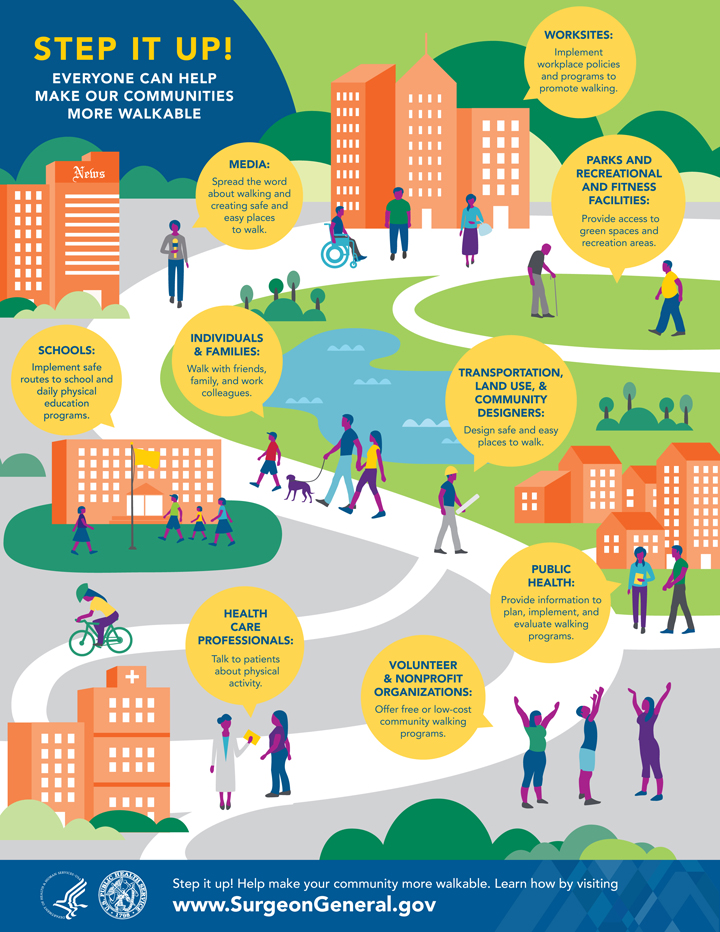AARP Hearing Center
Surgeon General Rx: More Walking, Walkable Places
By Jay Walljasper, September 9, 2015 05:57 PM

In his just-released Call to Action on Walking, U.S. Surgeon General Vivek H. Murthy announced a national campaign to encourage Americans to walk more and make all communities safer and easier for walking. His office will partner with schools, citizens groups and businesses to meet these goals. (To get people moving they’ve even loaded a walking playlist on Pandora.)
>> GET LIVABLE! Subscribe to the award-winning AARP Livable Communities Monthly eNewsletter
“Walking is a simple, effective and affordable way to build physical activity into our lives,” Murthy says. “That is why we need to step it up as a country ensuring that everyone can choose to walk in their own communities.”
The landmark report — which is being compared to the surgeon general’s 1964 warning on the dangers of smoking — is based on definitive medical evidence that moderate physical exercise boosts your health, cutting your chances of diabetes, dementia, depression, colon cancer, cardiovascular disease, anxiety and high blood pressure by 40 percent or more.
A major study released this year shows that lack of exercise is twice as deadly as obesity, according to Cambridge University researchers who studied more than 300,000 people over 12 years. Their findings match another comprehensive study that found sitting for long periods is linked to higher death rates.
The federal Centers for Disease Control and Protection (CDC) recommends Americans walk at least 30 minutes a day, five days a week — or bike, run, swim, dance, garden, do aerobics and play sports. (For kids, it’s 60 minutes a day, seven days a week.)
The rising tide of walkers across America brings other benefits, too.
Stronger communities: “Exercise is medicine. It’s also good for the social fabric of our communities,” says Regina Benjamin, U.S. surgeon general from 2009 to 2013, explaining why she added a walking path to the grounds of her health clinic in rural Alabama. “Health does not just happen in doctors’ offices and clinics — it happens where we work, live, play and pray,” she says.
“What makes people walk is what makes great places to live,” adds Harriet Tregoning, head of the Office of Community Planning at the U.S. Department of Housing and Urban Development (HUD). “Walkability is the secret sauce that improves the performance of many other things.”
A stronger economy: “Walking is a business issue. A healthy workforce means a more successful workforce,” says Karen Marlo, vice president of the National Business Group on Health, a consortium of leading companies across many fields. Indeed, communities with many walkable neighborhoods do better economically than those with just a few, according to a report from the George Washington University School of Business.
Lower cost of living: Transportation costs rival housing costs for many American families today, especially those living in places where it is hard get around without a car (25 percent of household expenses) compared to walkable communities (9 percent), according to the Federal Highway Administration. The yearly costs of owning and operating a car average $8,698, which means that figuring out how to walk more and drive less makes economic sense, according to the American Automobile Association.
Despite these and many other benefits, Americans walk less than people in most other countries. In fact, Australians walk almost twice as many steps each day as we do, a surprise in a country that is similar to the U.S. with high rates of car ownership and spread-out suburban development.
While 94 percent of Americans participating in a national survey said that walking is “good for their health,” 79 percent admitted they “should walk more.” So what’s stopping them?
- Forty percent of people said their “neighborhood is not very walkable.”
- Forty percent said there are “few places within walking distance of my home.”
- Thirty-nine percent said they “don’t have time.”
- Twenty-five percent cited a “lack of sidewalks or speeding traffic.”
- Twenty-five percent cited “no one to walk with.”
- Thirteen percent cited “crime in my neighborhood.”
“Everyone deserves to have a safe place to walk or wheelchair roll,” says Surgeon General Murthy. “But in too many of our communities, that is not the reality.”
Jay Walljasper is a writer, speaker and consultant on making our communities great places for everyone and author of The Great Neighborhood Book . He is the urban writer in residence at Augsburg College in Minneapolis and a senior fellow at Project for Public Spaces. Contact him at JayWalljasper.com.
LEARN MORE ABOUT LIVABLE (WALKABLE) COMMUNITIES
- AARP.org/livable
- AARP Livability Index
- AARP Livability Fact Sheets
- Slideshow: In a Livable Community, People of All Ages Can ...
- Slideshow: Dangerously Incomplete Streets
- Walking the Walk So "EveryBody" Can Walk
- Why Walking is Going Places
- 13 Solutions for a More Walkable America
- AARP Livable Communities Walkability Archive































































